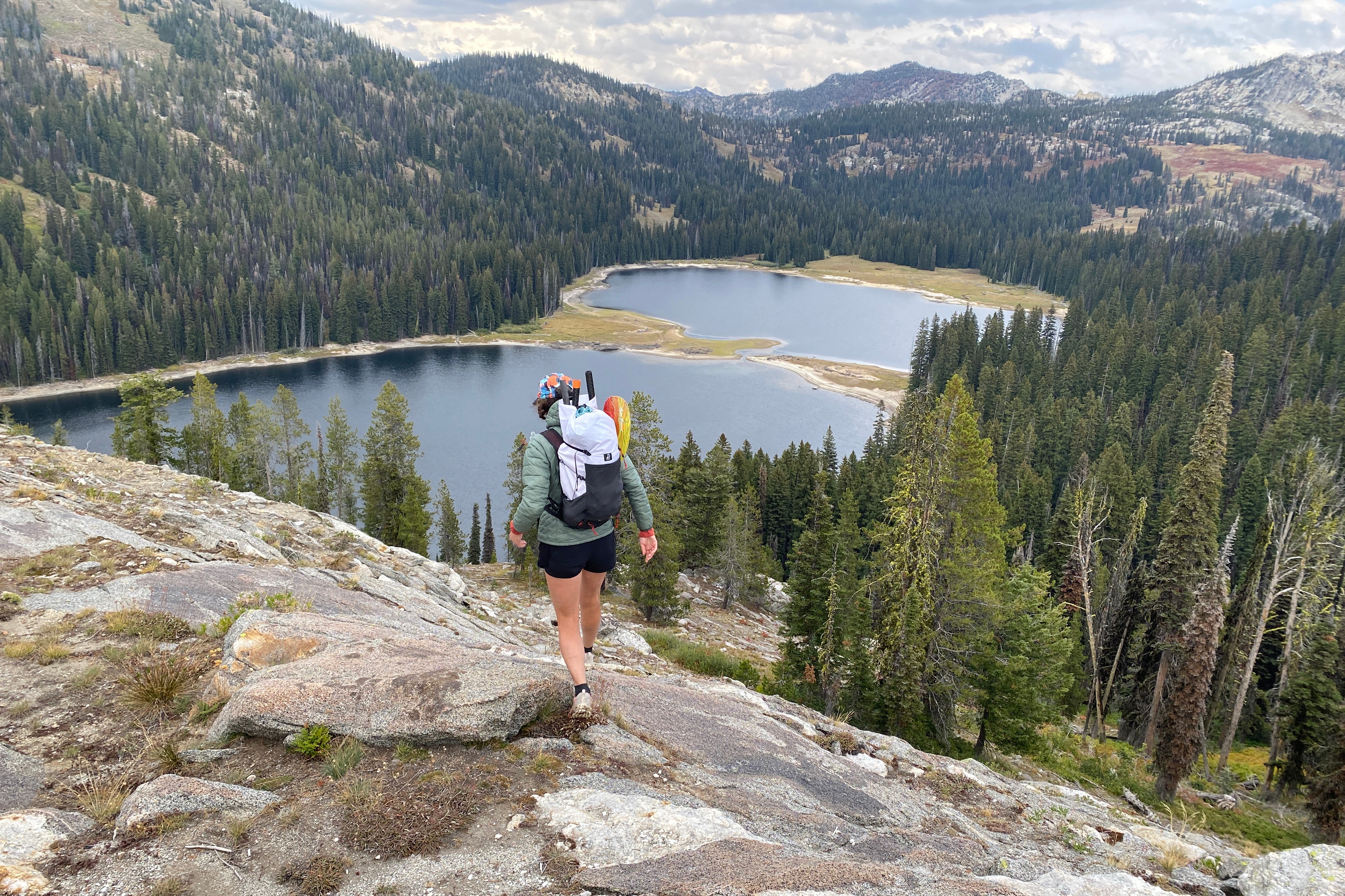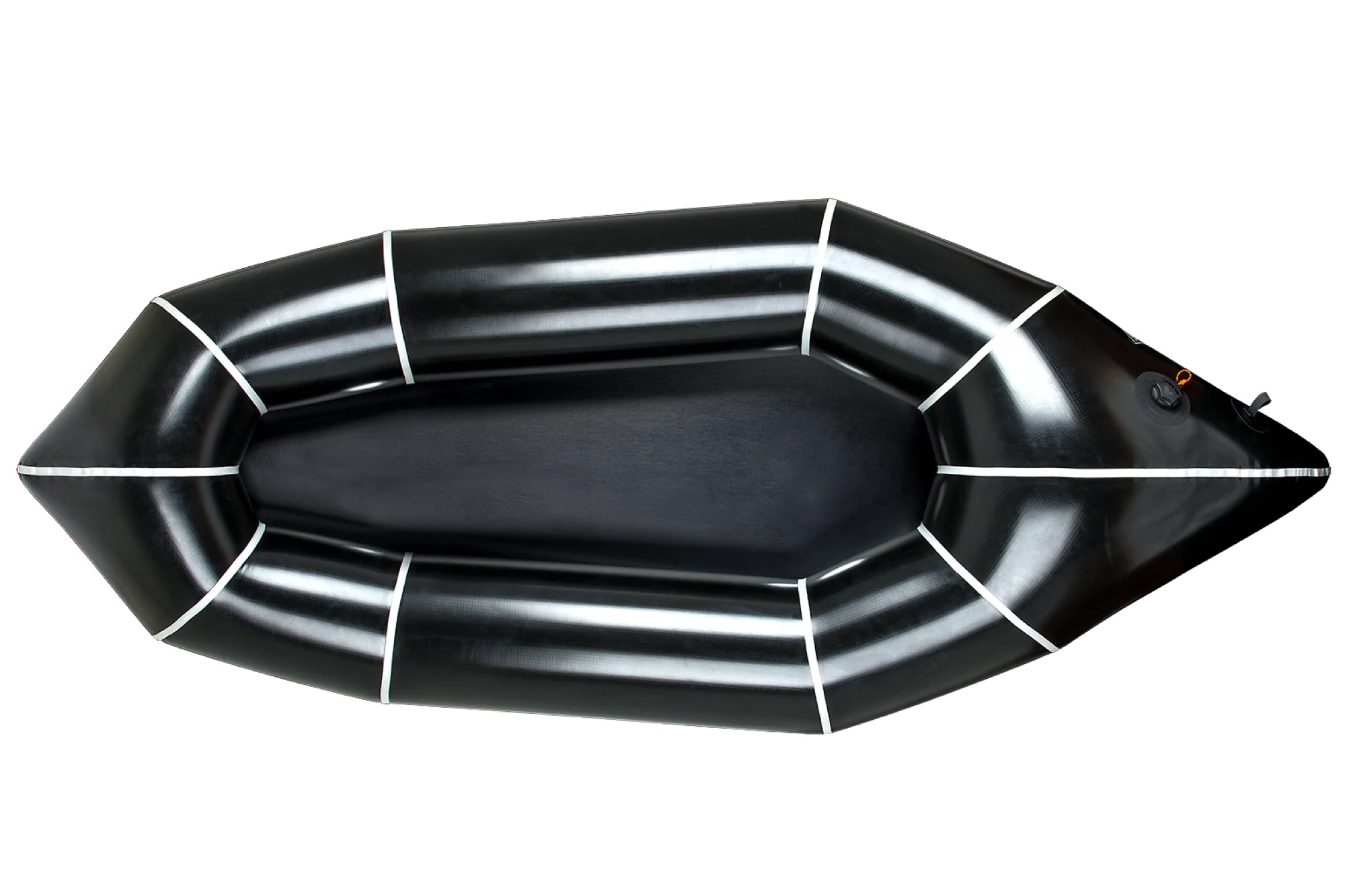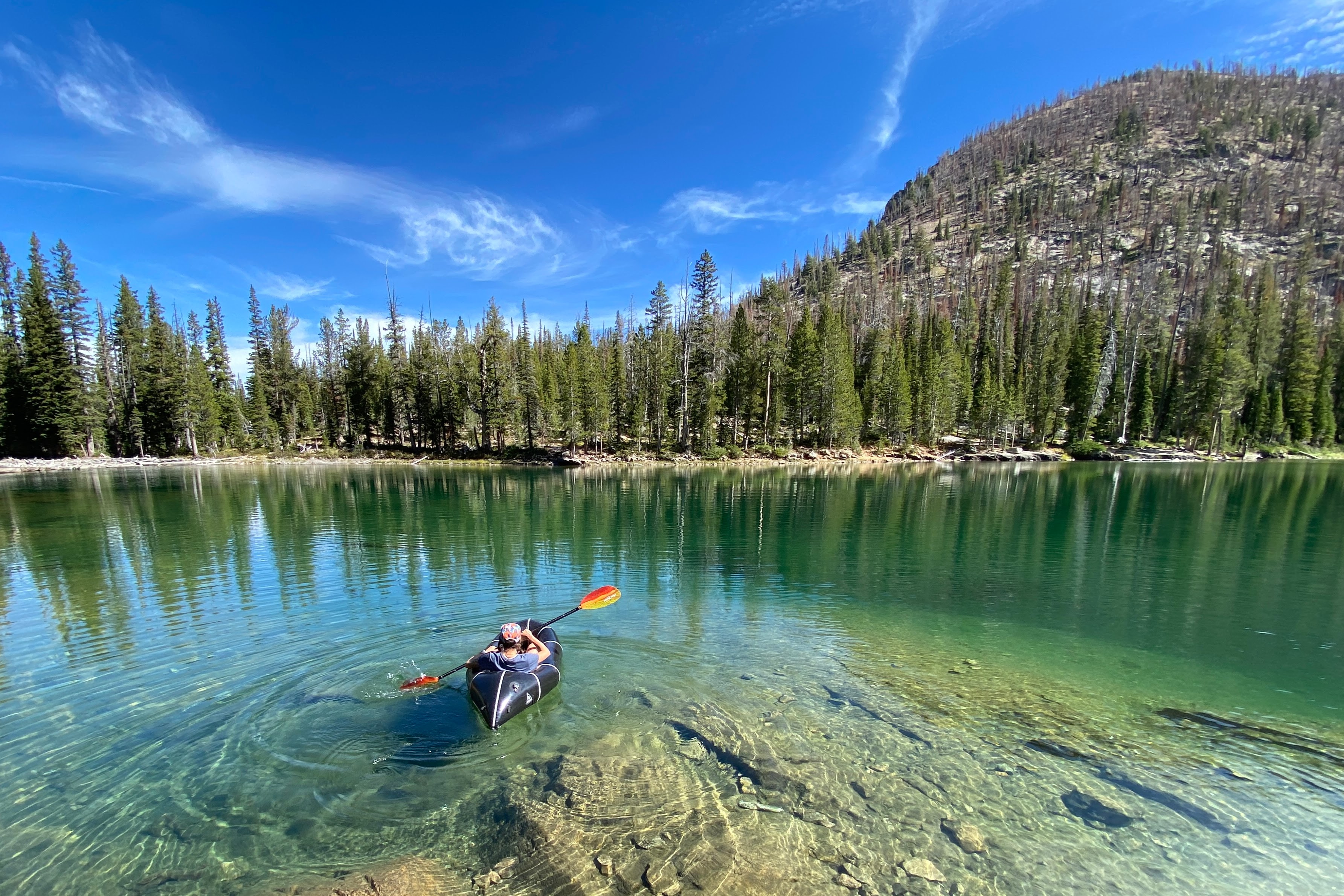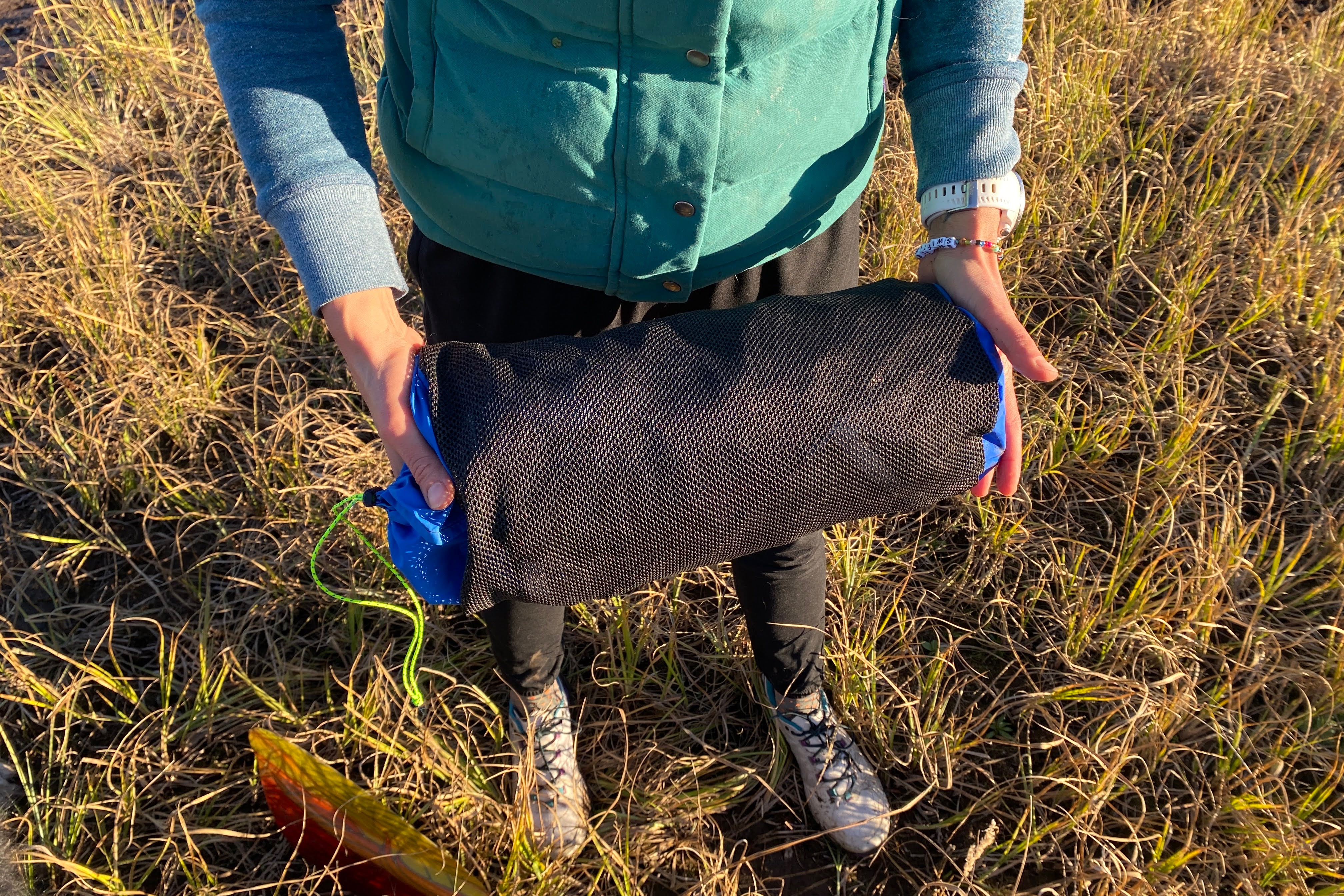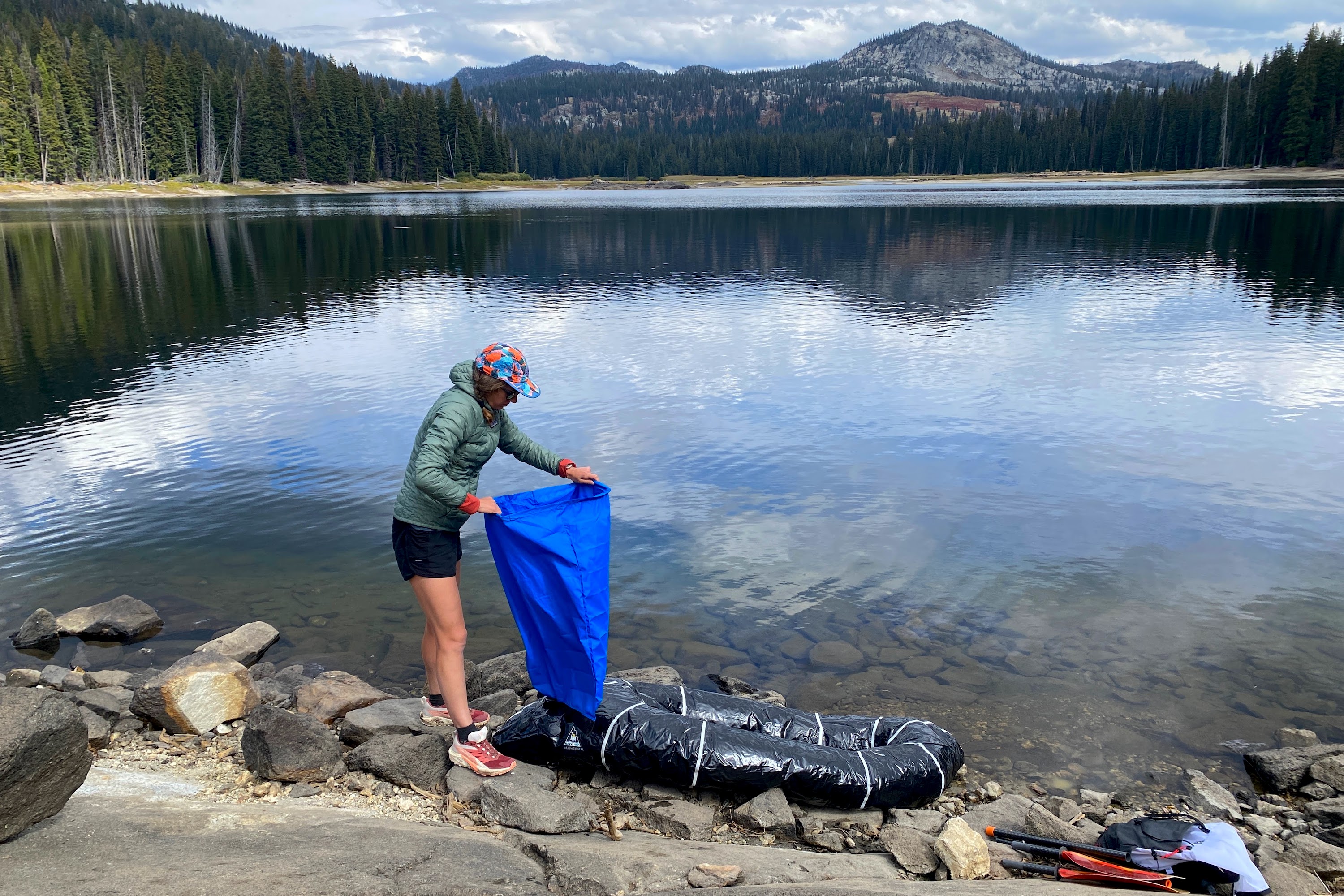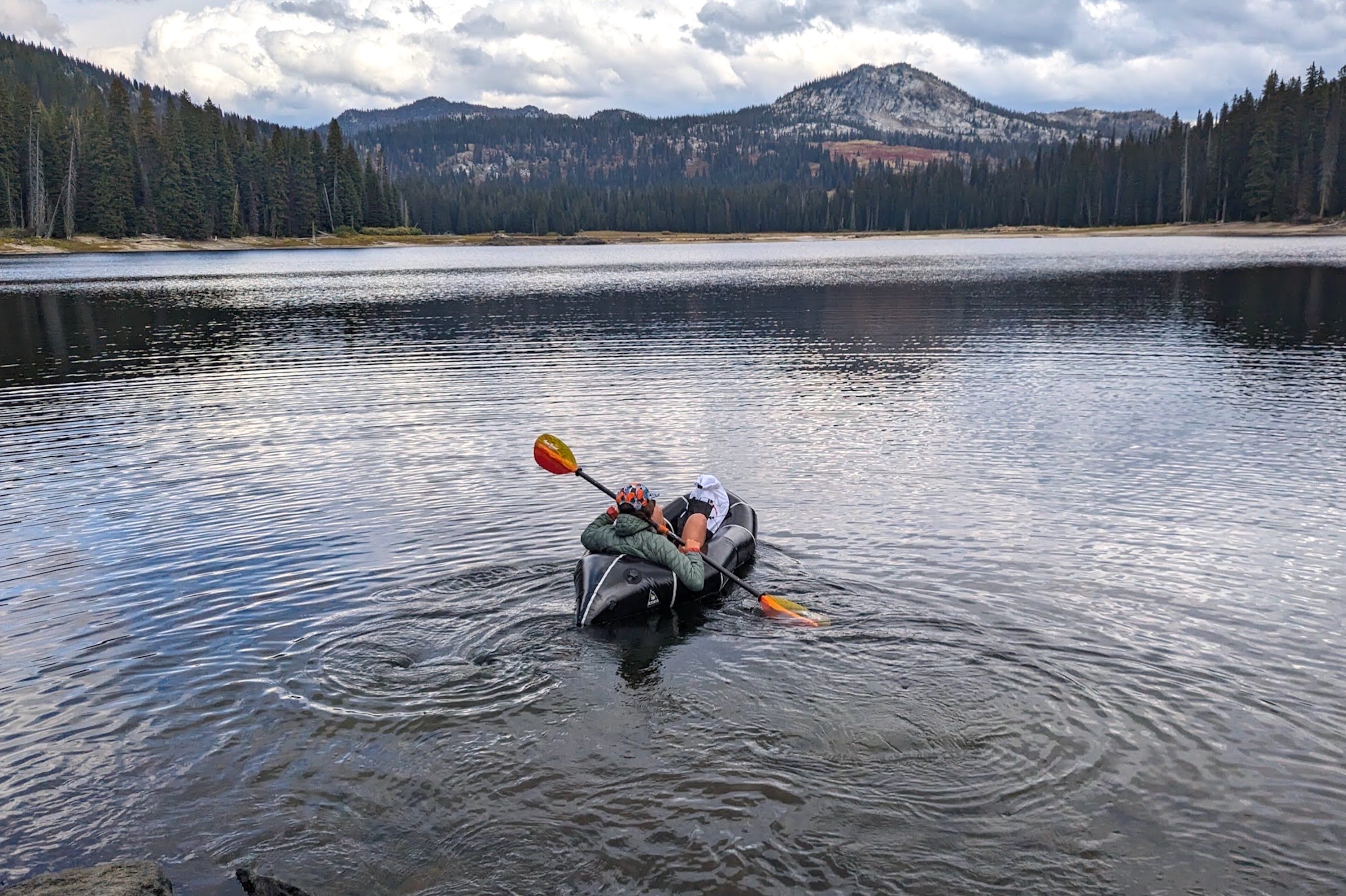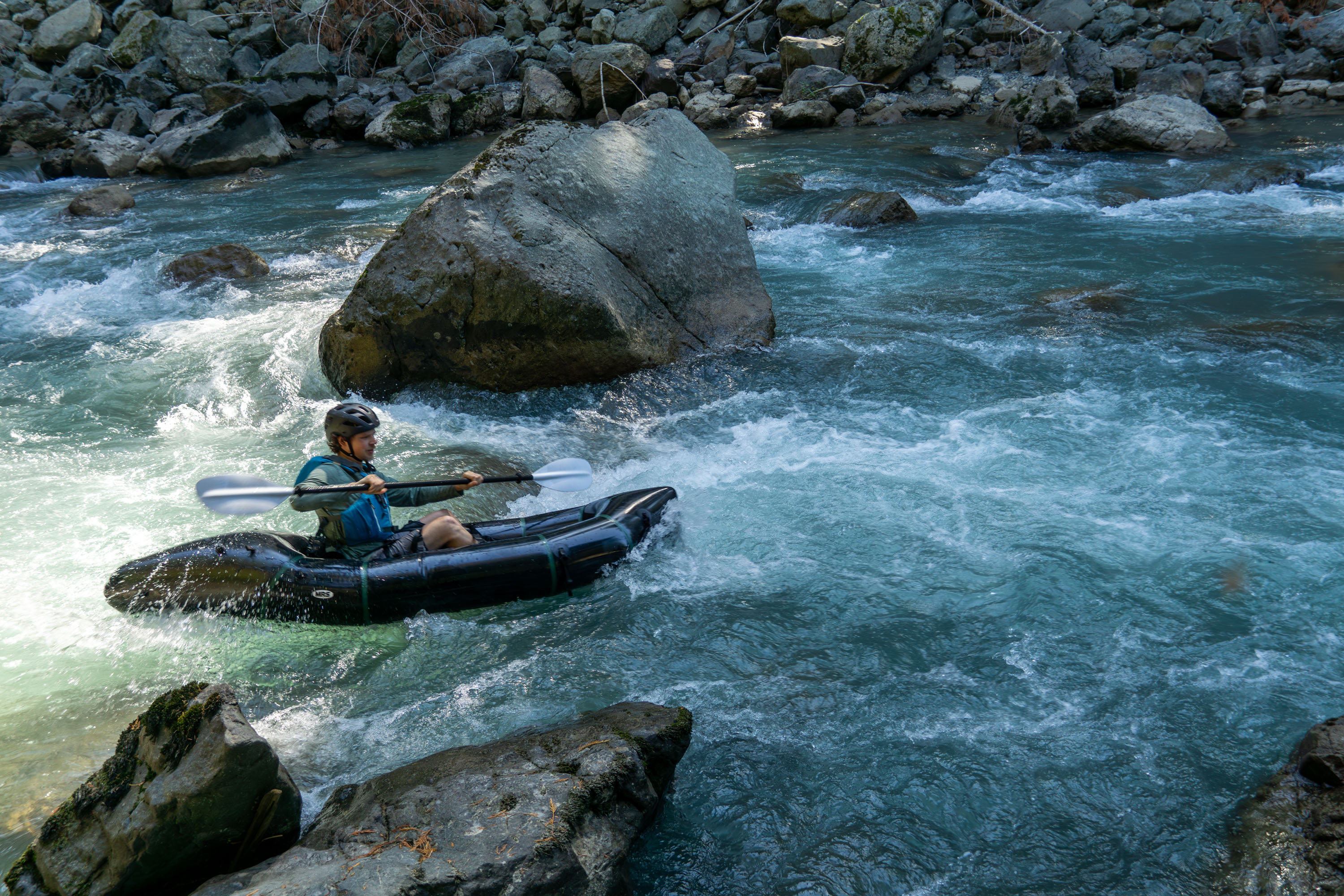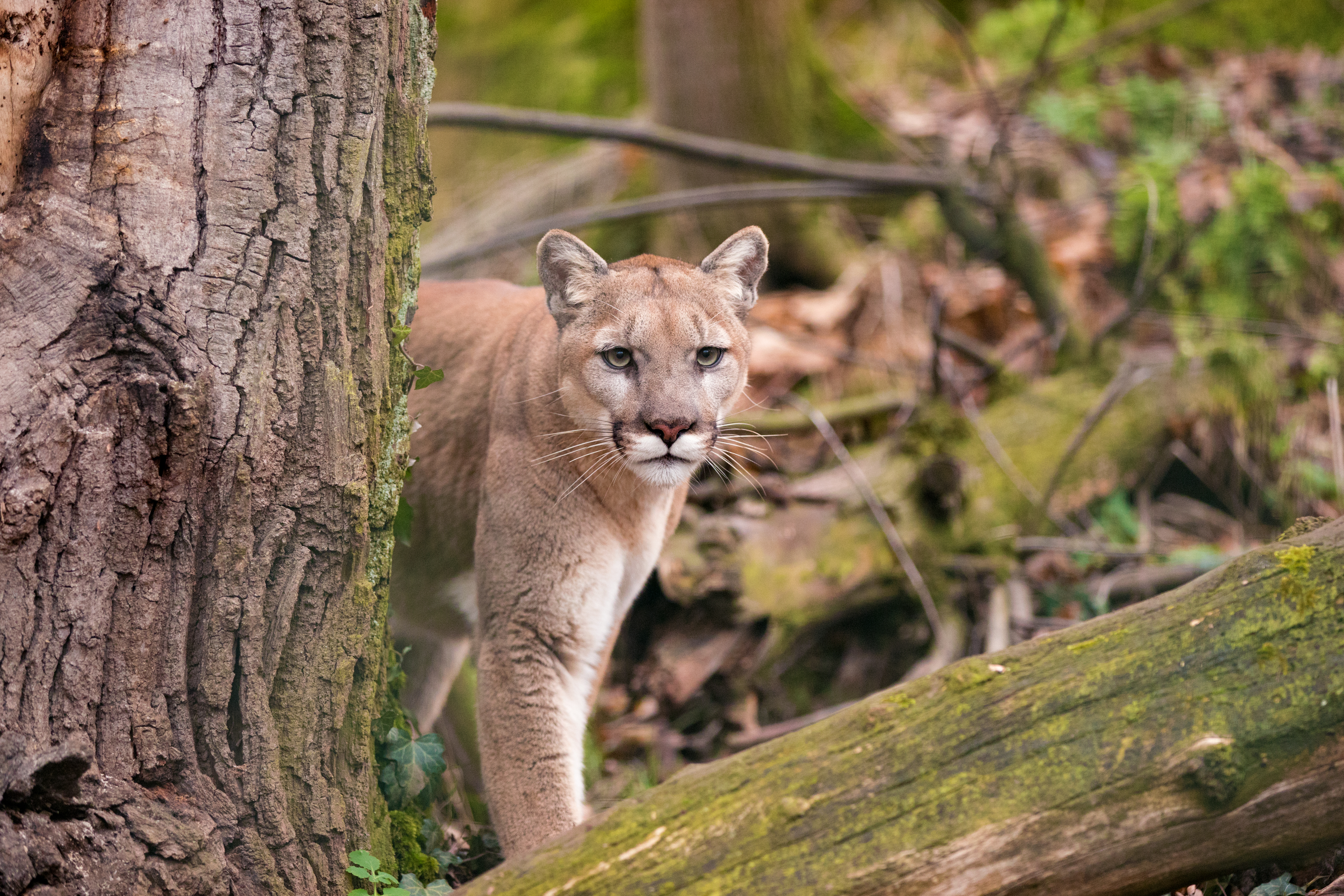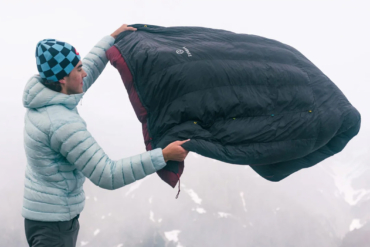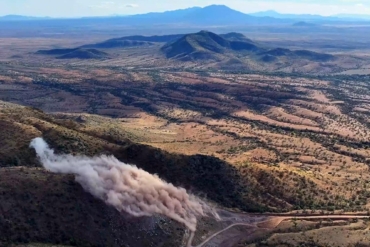My legs burned as I stepped from boulder to boulder on a granite-strewn trail in Idaho’s Payette National Forest, but it wasn’t from the weight I was carrying in my pack. I’d finished the McCall-based IMTUF 100-mile trail running race 3 days before, and then stuck around to explore the area at a more relaxed pace.
Slow hikes and paddling around alpine lakes in the Alpacka Raft Ghost let me savor the landscape I’d just run through while also giving my legs a break. And since the ultralight packraft weighs only 2.3 pounds, it had the right fun-per-ounce ratio.
Over the course of several weeks from mid-September through October, I tested the Ghost on alpine lakes and flat water around Idaho and Oregon. My objective on this first outing was Boulder Lake, which I’d run by twice during the IMTUF race.
This time, I was able to access the lake via an easy 2.5-mile route that gradually ascends Boulder Lake Trail #105. In my pack, I carried the Ghost, a lightweight four-piece paddle, a liter of water and a water filter, a sandwich and snacks, and a few extra layers for the autumn temperature swings.
In short: The Alpacka Raft Ghost ($750) is an ultralight packraft that packs down to the size of a sleeping pad you’d use for backpacking. It’s easy to inflate using the included inflation bag and takes only minutes until it’s ready to go. Since this is a specialized packraft that was designed for activities like running, canyoneering, and fastpacking, the Ghost’s reduced weight comes at the cost of durability, and to some degree, comfort. If the weight limit and minimalist style packraft is a fit for you, there’s also another bonus: this packraft is a really great price, under $800. Typical packrafts can run anywhere from $1,000 to $1,900.
- Weight: 2 lbs., 4 oz.
- Load Capacity: 225 lbs.
- Packed Size: 11 in. x 5 in.
- Water Rating: Flat water, mountain lakes, simple river crossings
- Material: Proprietary ultralight 70D nylon hull and 200D nylon floor
- Tube Diameter: 10"
- Interior/Exterior Length: 44" / 84"
Pros
- Incredible lightweight and packable size
- Maintains a proven raft design
- No cheap valves here, comes standard with Alpacka’s temper assist valve
Cons
- Long-term durability won’t be all there
- Load capacity is fairly low
Alpacka Raft Ghost Packraft Review
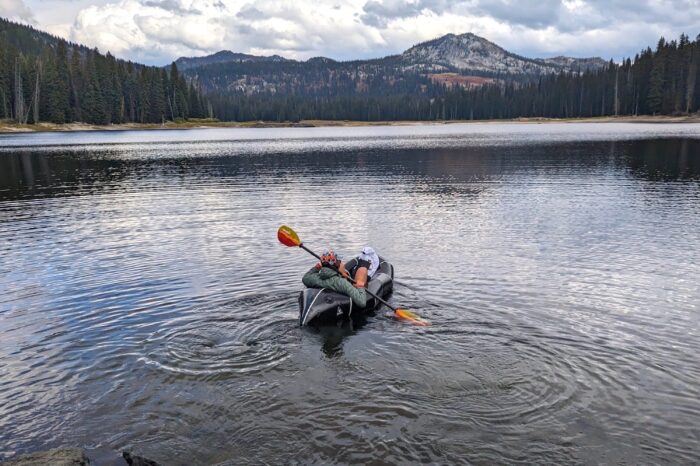
Materials and Build Quality
With the Ghost, Alpacka Raft sought to create the lightest packraft possible for activities like running and canyoneering, and was willing to compromise durability to do so. As a result, this packraft has a proprietary 70-denier nylon hull and a 200-denier nylon floor.
For comparison, other packrafts commonly have 210-denier material (such as nylon, polyester, or TPU) in the hull and 420- to 840-denier material in the floor. (The balance of weight to durability to performance is a crucial factor to keep in mind.)
Denier refers to the thickness of threads woven into textiles or fabrics. Higher denier means more strength, sturdiness, durability — and weight. The difference between 70- and 210-denier is significant, and the Ghost’s low-denier build requires a gentle hand. A better option for everyday and hard use is Alpacka’s Scout, which has a similar design but uses higher-denier materials and weighs about a pound and a half more.
So what does that weight-shave get you? The Ghost is a minimalist packraft with 10-inch tubes, an open build, and two grab loops on the stern. It is not available with Alpacka’s usual customization or add-on options like the cargo fly, spray deck, or self-bailing configurations.
In fact, this packraft doesn’t even come with a seat, which I became acutely aware of when I sat down in the raft on a frigid alpine lake in Idaho’s Sawtooth Mountains. Note, the seat included with Alpacka’s Scout (and sold separately for $50) will also fit in the Ghost, but there is no attachment. Sitting on your pack or a jacket will also provide some extra insulation and comfort.
Inflating and Deflating the Ghost
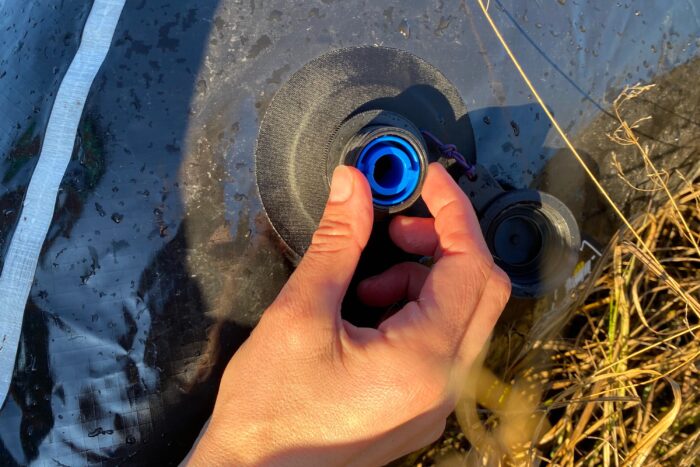
This packraft is simple and intuitive to inflate and deflate, and the process is quick. The Ghost has the same system as Alpacka’s other rafts, using a single valve and an included inflation bag. Before inflating the raft, turn the valve stopper counterclockwise all the way to the left. This will ensure that the valve stops air from releasing back out during inflation.
Next, thread the inflation bag onto the valve, and shake out any twists in the bag. To capture air, shake the inflation bag or scoop air and then either bunch the top of the bag in your hand or fold it together to seal the air inside. From there, you can roll the top down or use whatever method you like to push the air into the raft.
It took me a few rounds to get proficient at this, but eventually I was able to capture a bag full of air on each repetition. The Ghost only needs about five or six rounds of capturing air until it’s full. Once the packraft seemed fully inflated, I topped it off with a few breaths directly into the valve.
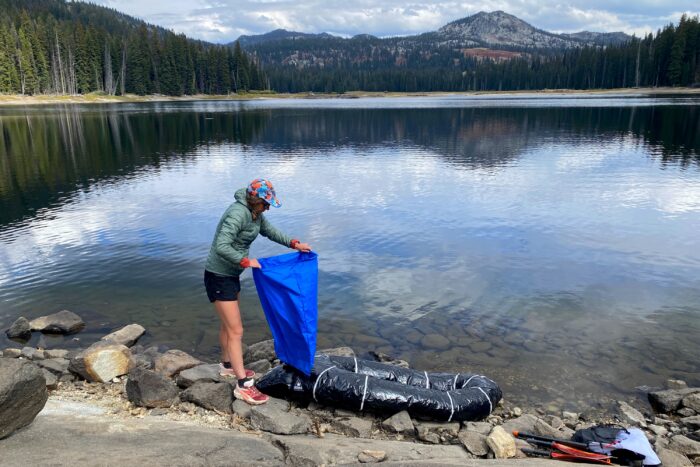
One thing I noticed when launching the Ghost onto very cold water was that it would lose a little bit of air pressure after a few minutes. To counter this, I inflated the packraft and let it float on the water for a few minutes, and then topped it off again before pushing off the shore. Alternatively, I paddled for a few minutes near the shore, and then pulled over and added a couple of breaths of air to top it off.
As a newbie packrafter, it’s entirely possible that I wasn’t fully inflating it on my first attempt. However, it is normal for inflatables to lose some air pressure when going from the shore onto very cold water (such as the Deschutes River in Oregon, which measured 37 degrees F in late October). Once I knew what to expect, it was no big deal.
Deflating and repacking the Ghost is easy and takes only a few minutes. Simply turn the valve stopper clockwise to the right, and then fold it together while rolling it up. I made sure to brush any debris off the raft as I folded and rolled it up, so the delicate material wouldn’t abrade while in its stuff sack.
Weight and Packability
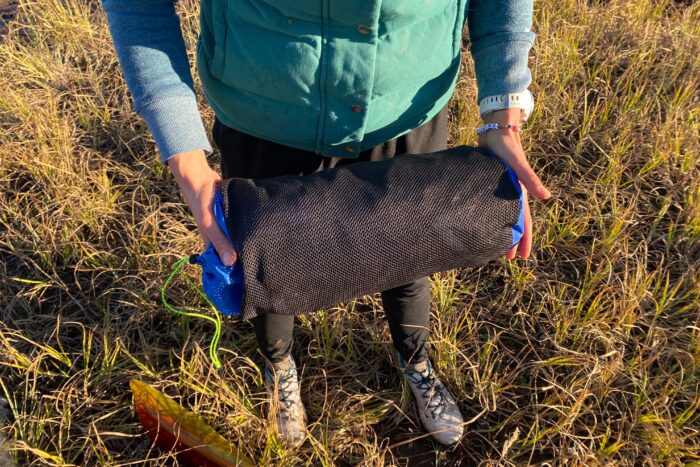
The Ghost is specially designed to be so lightweight that even runners won’t notice the extra weight they’re carrying, so it’s no wonder that its ultralight weight is its primary feature. Additionally, this raft packs down to about 14 x 4.5 inches, which is comparable to the size of a backpacking sleeping pad.
With a little patience and focused attention, the Ghost is easy to pack into a compact size. I used the same technique on this packraft that I use for my inflatable sleeping pad — using my body weight to fully deflate it while carefully folding it in on itself and also tightly rolling it. I found that if I don’t rush the process, the packraft fits easily back into its mesh stuff sack.
On more than one occasion, the packraft was wet and muddy, and I didn’t want to pack it tightly like that. Instead of putting it back into its stuff sack, I loosely packed it into my daypack (a 30L fastpack for reference). This worked well, and I still had plenty of room for my water bottle, hat, and extra layer. When I got home, I was able to shake it out and clean it thoroughly before storing it.
Performance on Water and Trail
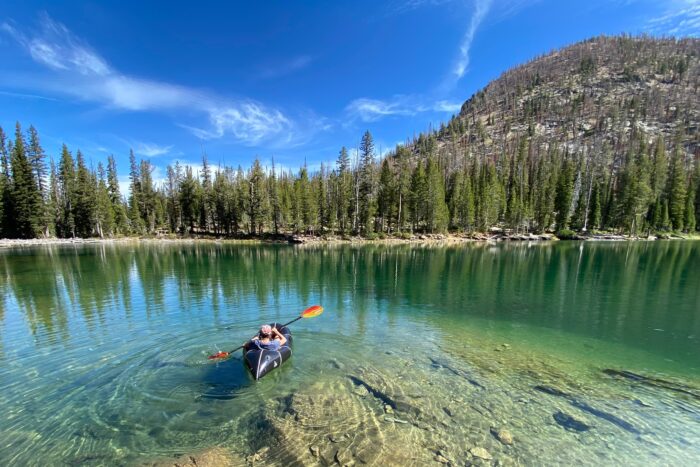
On water, the Ghost is easy to maneuver, and it tracks better than I expected considering its minimal weight. I had no issues directing the packraft where I wanted it to go on alpine lakes and flat rivers. And, I was able to glide around smoothly, though I had to put some muscle into my paddle strokes when I turned into a headwind on one blustery afternoon on Idaho’s Bull Trout Lake. Despite the lack of a seat, I never got uncomfortable while sitting in the boat, and I could easily shift my position for better positioning or paddling efficiency.
The Ghost has a listed maximum capacity of 225 pounds. While this doesn’t seem like a lot — and I wouldn’t want to max out a packraft that’s less durable than others — it’s more than enough for my body weight plus an overnight backpack. At the same time, there’s not a ton of room on the floor of the packraft (the interior length is 44 inches), so that would be something for very tall people to consider.
On the trail, I could have forgotten I was carrying a packraft at all — except for the paddle. Although it only weighs 26 ounces, the paddle made running with this setup slightly awkward.
I was able to cinch down the paddle pieces in the side pockets of my fastpack so that they didn’t bounce around. But, I am not sure how I’d attach the paddle to a running hydration vest, especially one that isn’t equipped with trekking pole attachments.
In addition, it would be challenging to fit the packraft itself (no matter how compact) into the typical running hydration vest. As a result, I’ve preferred hiking and fastpacking with the Ghost over running.
Conclusion
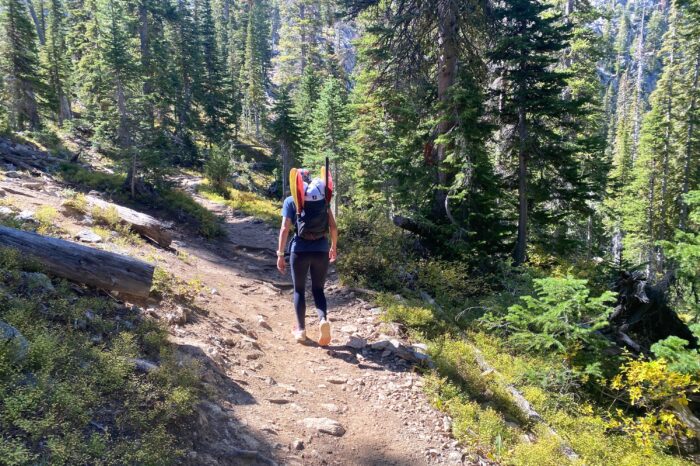
The Alpacka Raft Ghost packs a ton of fun into an ultralight, 2.3-pound, compact design. This packraft inspires me to mix a little more adventure into regular backpacking, fastpacking, bikepacking, or hiking outings. And, when I’m not running 100-mile races, to plan leisurely run routes that take me to as many alpine lakes as I can.
That said, this packraft’s main limitation is that it’s made with lower-denier materials than typical packrafts. While this keeps the Ghost super lightweight, it also means that it’s less durable than others. Therefore, it’s crucial to be gentle with the Ghost and keep it on smooth water that doesn’t have rocks or other obstacles near the surface. While testing this packraft, I was also careful not to drag it over a rocky shoreline — a sight you’ll frequently see in the alpine.
Although I would add the Ghost to my gear list for many activities, I don’t see myself bringing this packraft on trail runs. Mainly because running with even a lightweight, four-piece paddle starts to feel unwieldy pretty quickly.
That said, the Ghost and the paddle were comfortable and stable while using a fastpack. Best of all, this setup sparks my creativity about additional ways to travel through mountainous or backcountry terrain with a packraft in tow.
For diehard minimalists who love water and the alpine, this packraft is likely a win.
